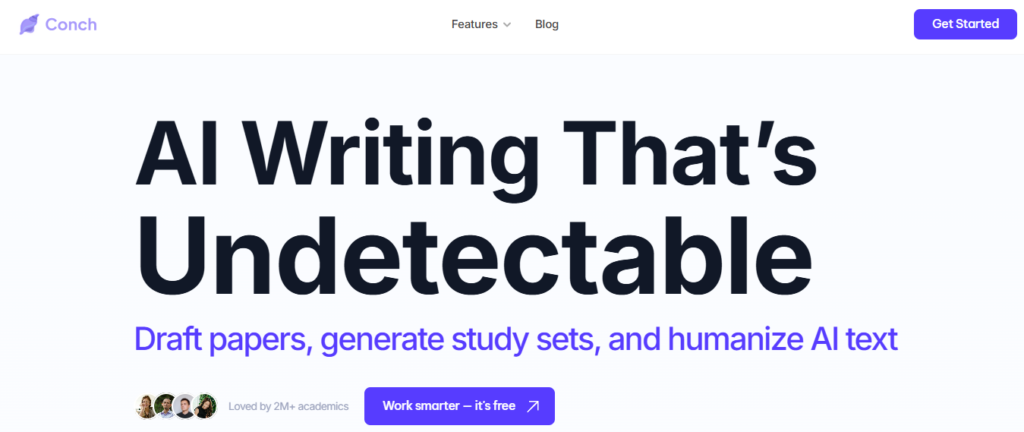Writing an evaluation essay can be a daunting task. First, you need to choose a suitable topic, then gather and analyze information before writing your paper. The process can be overwhelming, especially if you’re under a tight deadline. Luckily, with the help of AI writing tools like Conch AI, you can speed up the process of writing an evaluation essay and reduce some of the stress that comes with it.
In this guide, we’ll discuss how to use AI to write a paper with a focus on evaluation essays, starting with some helpful examples. Conch AI’s AI writing tool and easy-to-use program can generate evaluation essay examples and even help you write your paper, so you can go from stressed out to organized and confident in no time.
6 Evaluation Essay Examples

Evaluation essays are versatile pieces of writing that assess the value, quality, or significance of a subject based on specific criteria. These essays can adopt various structural formats, each serving a distinct analytical purpose. Here are the six core evaluation essays, explained in detail.
1. Argumentative Evaluation Essay
An argumentative evaluation essay is anchored in a clearly defined claim regarding the subject being critiqued. The writer develops an argument by offering logical reasons and concrete evidence, strategically seeking to persuade readers of their judgment. This approach combines critical assessment with persuasive writing, ensuring credible sources or examples substantiate every claim.
In this format, the writer typically addresses counterarguments, weighing differing perspectives before reinforcing their stance. The evaluation evolves into a debate, where the primary goal is not just to rate the subject, but to establish the superiority or inferiority of its qualities through well-reasoned argumentation.
Such essays are often used to address topics that generate debate or controversy. The effectiveness of the argumentative evaluation lies in its ability to sway the reader’s opinion by fusing robust evidence with compelling logic.
Example of Argumentative Evaluation Essay
“Assessing whether remote work boosts employee productivity, arguing that flexible work environments lead to higher output and job satisfaction when compared to traditional office settings.”
2. Analytical Evaluation Essay
An analytical evaluation essay undertakes a comprehensive examination of the chosen subject, breaking it down into its core elements for a detailed analysis. Instead of focusing on an overall impression, this essay examines specific aspects, such as structure, technique, or style, and evaluates how each contributes to the subject’s overall quality. Writers often employ this style when a subject is multidimensional, allowing for an exploration of different facets that collectively determine its merit.
This can apply to works of art, performances, products, or services, demanding a meticulous and methodical approach to evaluation. The strength of an analytical evaluation essay lies in its depth, providing readers with a well-rounded understanding of why the subject excels or falls short in key areas. By the end, the audience should have insight into how every component functions within the bigger picture.
Example of Analytical Evaluation Essay
“Analyzing the cinematography, thematic depth, and character arcs in a recent film to evaluate its overall effectiveness as a piece of modern cinema.”
3. Comparative Evaluation Essay
A comparative evaluation essay aims to juxtapose two or more subjects, evaluating them against the same standards or benchmarks. This format highlights both shared and divergent attributes, painting a clear picture of which option stands out best under specific criteria.
Writers who choose this format aim not only to point out differences and similarities, but to clarify which subject is superior once all factors are considered.
The comparative essay thrives on clear criteria, ensuring fairness and clarity in each assessment made. This style is particularly well-suited to helping readers make informed decisions where choices abound, whether between products, methods, concepts, or experiences. The ultimate goal is to provide an informed, unbiased assessment of which subject prevails under the outlined standards.
Example of Comparative Evaluation Essay
“Comparing online and in-store shopping based on user convenience, product variety, and customer service to determine the better option for modern consumers.”
4. Descriptive Evaluation Essay
A descriptive evaluation essay focuses on delivering a vivid, sensory-rich portrayal of the subject while also offering a thoughtful judgment of its qualities. This style is distinct in that it first paints a detailed picture, using concrete details and figurative language to immerse the reader in the subject’s experience. The primary goal is to capture the nuances of the subject and shape the reader’s perception through description. Once the scene has been set, the writer transitions naturally into an evaluative stance, critiquing the subject’s characteristics, strengths, and potential shortcomings.
The effectiveness lies in how well the writer can blend objective observation with subjective analysis, providing not only what is seen, heard, or felt but also interpreting those elements for the reader. Descriptive evaluation essays are especially impactful when the subject is something experiential or sensory-rich, such as a place, a work of art, an event, or an experience. The reader should emerge with both a mental image of the subject and a clear understanding of its value.
Example of Descriptive Evaluation Essay
“Describing the atmosphere, menu, and service of a local vegan café to evaluate its appeal to health-conscious diners.”
5. Cause and Effect Evaluation Essay
A cause and effect evaluation essay centers on analyzing the relationships between actions or conditions and their resulting outcomes regarding a specific subject. The writer identifies key factors that lead to particular effects, systematically examining whether the stated causes truly contribute to the observed results. This approach is beneficial when trying to understand the underlying mechanisms or consequences of an issue.
The writer supports their evaluation with relevant data, examples, or case studies that highlight why certain factors are significant, and measures the scale of their impact. Such essays are invaluable in fields such as social sciences, education, business, or public policy, where understanding causality is crucial to forming recommendations or drawing conclusions. Practical cause-and-effect evaluation lays the groundwork for proposing solutions or further research.
Example of Cause and Effect Evaluation Essay
“Exploring the link between school start times and student academic performance, evaluating how later start times impact learning outcomes.”
6. Narrative Evaluation Essay
A narrative evaluation essay seamlessly integrates personal storytelling with critical assessment, providing readers with a firsthand perspective on the subject. The evaluator recounts specific experiences or anecdotes that are both relevant and illustrative of the central judgment they wish to convey. The power of this format comes from its ability to personalize the evaluation, blending reflective insights with descriptive storytelling.
This approach fosters an emotional connection, as the reader gains insight into the evaluator’s genuine reactions, challenges, and transformations encountered during their experience with the subject. A narrative evaluation can be particularly persuasive when the subject’s value or effectiveness is best demonstrated through lived experience. The essay not only concludes but also explains the reasoning behind those judgments using personal engagement as evidence.
Example Narrative Evaluation Essay
“Sharing a student’s journey using a language learning app to evaluate its effectiveness in developing real-world conversational skills.”
Join Over 2 Million Students and Ace your Classes with our AI Writing Tool
Join millions of students to write papers and ace exams with Conch AI’s AI writing tool. We built this tool because we were tired of spending endless hours on citations, study guides, and rewrites. Unlike general AI tools, Conch understands what students need – instant citations that professors accept, stealth writing that bypasses detection, and study tools that help you learn the material.
Our Chrome extension brings these superpowers directly to your research workflow, while our lecture recording feature takes notes for you, allowing you to focus on understanding the concepts. Try our free plan today and see why students tell us they’re saving 10+ hours a week with Conch AI. When you’re ready for unlimited access, our Limitless Plan gives you everything you need to transform your academic experience. Join over 2 million students and ace your classes with our AI writing tool!
Related Reading
- How to Calculate H Index
- How to Write an Informative Essay
- Technology Essay
- How to Write a Header for an Essay
- How to Write a Biography Essay
- How to Write a Reflection Paper
- How to Write an Encyclopedia Entry
- Speech Analysis Example
- What is a Good H Index
What is an Evaluation Essay?

An evaluation essay is a type of academic writing that involves carefully assessing the quality, importance, or value of a particular subject. Unlike simple reviews or summaries, it requires in-depth analysis and reasoned judgment, backed by evidence and specific examples.
The main goal of an evaluation essay is to provide a balanced and objective critique of a particular topic. It aims to persuade readers by offering clear reasons and evidence for your opinion about the subject. Rather than merely sharing personal feelings, it focuses on a critical examination based on established standards and principles. Several components are necessary when writing an evaluation essay, such as:
Choosing the Subject of Evaluation
An evaluation essay revolves around a clearly defined subject. This subject could be anything from a book, movie, or restaurant to a product, service, or academic program. It’s crucial that the subject is relevant and that the criteria for judging it are directly applicable.
Setting Clear Criteria
A crucial part of writing an evaluation essay is establishing specific criteria to measure the subject against. These benchmarks act as a foundation for your assessment and should be precise, measurable, and relevant. Examples of criteria include performance, design, functionality, usability, effectiveness, quality, and value. Defining these helps create a systematic framework for your evaluation.
Objective and Evidence-Based Analysis
Objectivity is key in an evaluation essay. This means your analysis must be free from personal bias, relying instead on logical reasoning and factual evidence. Unlike casual opinions, your judgments must be supported by concrete examples and facts. For instance, if you claim a product is ineffective, you need to provide clear evidence demonstrating its shortcomings.
Providing Supporting Examples
Examples help illustrate both the strengths and weaknesses of the subject with regard to the criteria you’ve set. This makes your evaluation more convincing by showing how the subject meets or fails to meet the standards. Including relevant evidence not only strengthens your argument but also enhances the credibility of your essay.
Formulating Critical Judgment
Your critical judgment serves as the thesis statement, encapsulating the main point of your essay. It is formulated by weighing the subject’s pros and cons against your established criteria. A balanced judgment is essential. It acknowledges both positive and negative facets, presenting a fair conclusion based on thorough evaluation.
Using Comparative Analysis
Often, comparing the subject with similar options or recognized standards adds depth to your evaluation. This comparative approach highlights what makes your subject stand out or where it falls short. By providing context, comparisons enrich your analysis and help readers understand your conclusions more clearly.
Structured Organization
Like all strong academic essays, an evaluation essay follows a clear structure: an introduction, body paragraphs, and a conclusion. The introduction sets up the subject and presents your overall judgment. Each body paragraph addresses a specific criterion, offering detailed analysis and evidence. The conclusion summarizes your key points and reinforces your final evaluation.
How to Write the Structure of an Evaluation Essay

An evaluation essay is a structured form of writing that requires clear judgment based on specific criteria, supported by evidence and argumentation. The structure is essential to convey your assessment effectively and persuasively. This guide breaks down the crucial components of an evaluation essay and explains how to organize your content in a logical and coherent manner.
1. Title
The title of your evaluation essay should give readers an immediate sense of the focus and purpose of your analysis. It needs to be concise yet descriptive, offering a glimpse of what will be examined and the criteria used. For example, if evaluating an online education platform, a fitting title could be:
- “Evaluating LearnStream: Usability, Course Quality, and Student Support”
This title communicates the platform under review and the key points of assessment.
2. Introduction
Your introduction serves as the entry point for your readers. Begin with an engaging sentence that captures the reader’s attention and effectively introduces your topic. Follow this with background information that outlines the subject and provides the necessary context for understanding the evaluation.
- For instance, “In this essay, I will evaluate the new electric bicycle released by EcoRider, focusing on its speed, battery longevity, and rider comfort.”
- Next, establish the evaluation criteria. Explain why these criteria were selected and why they matter for judging the subject effectively.
- After setting criteria, end your introduction with a thesis statement that encapsulates your overall judgment and previews the points to be discussed.
Example thesis
“This evaluation will analyze the EcoRider e-bike’s top speed, battery capacity, and ergonomic design to assess its suitability for urban commuters.”
3. Body Paragraphs
Some helpful tips for writing the body paragraph of an evaluation essay include:
- Each paragraph in the body should be devoted to one of the criteria mentioned in your introduction.
- Begin each paragraph with a topic sentence identifying the criterion.
- Provide analysis supported by facts, examples, or data.
- Compare the subject against similar products or expectations to add context.
For example, regarding an e-bike’s battery life:
- “The EcoRider provides a battery range of up to 50 miles, outperforming many competitors in its price range, making it ideal for daily commuting needs.”
Optionally, include counterarguments to acknowledge other views. After presenting these, reinforce your evaluation by countering them with evidence.
Example
“Though some argue that the EcoRider’s weight reduces portability, its robust battery and motor performance justify the added heft for longer rides.”
4. Conclusion
In the conclusion, succinctly restate your thesis and the main points analyzed without introducing new information. Emphasize the implications of your evaluation and its significance for potential users or the broader context.
Example
“In conclusion, the EcoRider e-bike excels in essential areas like battery life and rider comfort, making it an excellent choice for urban commuters despite its slightly heavier frame.”
The Benefits of Using Conch AI as a Student
Join millions of students to write papers and ace exams with Conch AI’s AI writing tool. We built this tool because we were tired of spending endless hours on citations, study guides, and rewrites. Unlike general AI tools, Conch understands what students need – instant citations that professors accept, stealth writing that bypasses detection, and study tools that help you learn the material.
Our Chrome extension superpowers are right at your fingertips, enhancing your research workflow, while our lecture recording feature takes notes for you, allowing you to focus on understanding concepts. Try our free plan today and see why students tell us they’re saving 10+ hours a week with Conch AI. When you’re ready for unlimited access, our Limitless Plan gives you everything you need to transform your academic experience. Join over 2 million students and ace your classes with our AI writing tool!
Related Reading
- Essay on Respect
- Essay About Bullying
- Why I Deserve This Scholarship Essay
- Is Census Data Primary or Secondary
- Is a Documentary a Primary Source
- Are Textbooks Primary Sources
- Essay About Death
- How to Write a 4 Paragraph Essay
- Finance Research Paper Writing
How to Write an Evaluation Essay Using Conch AI

Writing an evaluation essay requires careful analysis of a subject based on defined criteria, supported by thorough evidence. Using Conch AI, a powerful AI writing assistant, can significantly enhance and streamline this process. Below is a step-by-step guide tailored to help you leverage Conch AI effectively for your evaluation essay.
1. Selecting a Focused Topic with Conch AI
Choosing the right topic is fundamental. Conch AI can assist you in brainstorming and refining a clear, specific subject that lends itself to an evaluative approach. Enter your general interests, and Conch AI will suggest relevant and manageable topics. Avoid overly broad themes; instead, opt for subjects that lend themselves to objective assessment, such as a recent film, a local restaurant, or a product, to ensure a meaningful analysis.
2. Defining Clear Evaluation Criteria
Next, establish precise criteria with the support of Conch AI. This tool can help you identify relevant standards directly linked to your topic’s nature, whether performance, design, usability for products, or plot development and character interaction for media. Clear criteria provide a structured framework for systematic evaluation, enhancing the depth and clarity of your judgment.
3. Gathering and Organizing Evidence
Conch AI can guide your research by suggesting credible sources and methods for collecting supporting data, including statistics, expert quotes, and relevant examples. Utilize the AI to compile this information logically, ensuring that your evaluation is based on verifiable evidence and comprehensively covers both strengths and weaknesses.
4. Creating a Structured Outline
Use Conch AI to draft a detailed outline, dividing your essay into its essential parts: introduction, explanation of the criteria, body paragraphs, and conclusion. The AI structures these elements clearly, promoting coherence and smooth progression. It can suggest how to sequence your points and incorporate counterarguments if applicable, making the writing process more efficient and organized.
5. Writing the Evaluation Essay with Conch AI
Now, with your outline and evidence ready, employ Conch AI to construct well-crafted paragraphs. Start with an engaging introduction that states your evaluation purpose and thesis. For each criterion, dedicate a paragraph supported by the evidence gathered, ensuring balanced and comparative analysis. Finally, conclude by summarizing your findings and reiterating your overall assessment without introducing new information. You can prompt Conch AI to generate complete draft sections, then refine the output to align with your voice and style.
6. Revising and Polishing Your Essay
After completing your draft, use Conch AI’s editing features to improve grammar, clarity, and stylistic consistency, ensuring a professional finish. The AI can also help rephrase sentences to enhance readability. Incorporate instructor or peer feedback for further refinement, validating the essay’s coherence and impact before submission.
Join Over 2 Million Students and Ace your Classes with our AI Writing Tool
Conch AI helps with all aspects of academic writing. Use it to generate ideas for your evaluation essay, create an outline, and even write a first draft. You can also use Conch AI to quickly find and insert citations in your paper, so you can ace your next assignment without getting bogged down in the details.
How Conch Improves the Writing Process
Conch AI streamlines the writing process so you can do less tedious work and get to the fun part of writing your evaluation essay. With Conch, you don’t have to spend hours researching to figure out what you’ll write about. You also won’t waste time staring at a blank page. Instead, you can generate ideas, create an outline, and write a draft of your evaluation essay in no time.
Getting help with academic writing doesn’t just improve your grades. It also helps you build confidence and develop better writing skills for the future. With Conch AI, you can make writing your evaluation essay quicker and easier, allowing you to focus on learning the material and improving your skills instead of getting stuck on the details.
Related Reading
- Ai Annotated Bibliography
- Leadership Essay Examples
- Social Media Argumentative Essay Topics
- Topic Sentence vs Thesis Statement
- National Honor Society Essay Examples
- Proposal Essay Examples
- Diversity Essay Examples
- Literary Analysis Essay Examples
- Informative Essay Topics
- Dyslexia Writing Examples

Leave a Reply